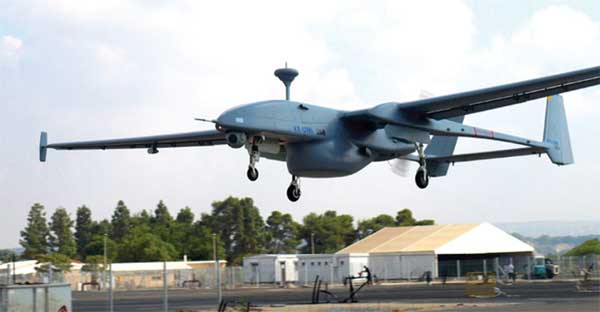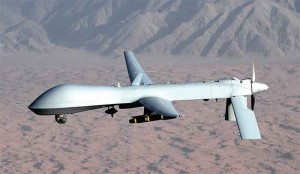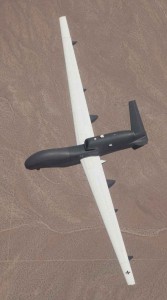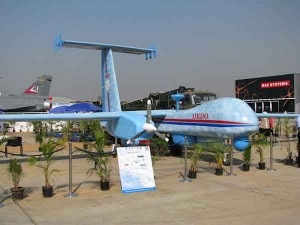The pace of India’s UAV acquisitions is likely to quicken over the next five years or so and the size of the Indian market during the same period is estimated at over $2 billion. According to an analyst of the Teal Group, quoted in the Times of India last year, “We see a growing market in India — 50 Medium-Altitude, Long-Endurance (MALE) UAVs, 60 Navy UAVs, 70 Air Force tactical UAVs, 100 Army tactical UAVs and 980 mini-UAVs over the next decade.” Indeed, the armed forces need UAVs of varying size and performance to meet requirements like border surveillance, communications and weapons delivery. The Indian Navy is in search of MALE UAVs and ship-borne rotary-wing UAVs and wishes to enhance its short-range capability. The Indian Army hopes to augment its existing fleet of Searcher Mk 2 UAVs and procure hundreds of mini-UAVs. Its priority is to keep a close watch on the borders with Pakistan and China. The IAF would like to bolster its MALE UAV holdings and is particularly keen to acquire UCAVs.
Almost 80 countries in the world already have some type of UAV and about two dozen possess armed devices…
For a decade or more, Unmanned Aerial Vehicles (UAV) have been constantly in the news, mainly on account of the exploits of the military and intelligence agencies of the United States in Iraq, Afghanistan and Pakistan. The convenient ‘targeted killings’ of top terrorists without risking the lives of pilots naturally holds instant appeal for American political and military leaders as they grapple with new crises in different parts of the world. Neither the doubtful legality of unmanned strikes which often claim innocent civilian lives, euphemistically called ‘collateral damage’ nor the increasingly shrill demands for curbs on such attacks have succeeded in dampening the booming market for UAVs.
Indeed, the Teal Group, a US defence market analysis firm, states that UAVs are the most dynamic growth sector of the global aerospace industry this decade. According to its report entitled “World Unmanned Aerial Vehicle Systems, Market Profile and Forecast 2014”, UAV spending worldwide is projected to nearly double in a decade – from the current $6.4 billion annually to $11.5 billion by 2024. And although interest in civilian applications of UAVs is increasing, 89 per cent of the market is still military.
Israel and the US are the world’s main sources of military UAVs. Almost 80 countries in the world already have some type of UAV and about two dozen either possess armed devices or are purposefully travelling down the path of weaponisation. However, the proliferation of Unmanned Combat Air Vehicles (UCAV), as the armed versions of UAVs are called, may not be rapid because in order to carry meaningful weapon loads, the platform would have to be fairly large as well as expensive and would require sophisticated ground control organisation.
Drones, as UAVs are popularly but mistakenly called, hold a natural attraction for poorer countries and militant outfits because they are a relatively more affordable way to obtain a degree of air capability. What is more, the list of non-state actors with UAVs is also growing. It is known to include Hezbollah in Lebanon and Hamas in Gaza. In July 2014, Israeli anti-aircraft missiles destroyed two Iran-manufactured Ababil UAVs flown by Hamas that does not hide its desire to field armed UAVs against Israel. And the day may not be distant when even Lashkar-e-Taiba can boast of its own small fleet of drones.
The earliest UAVs were meant purely for reconnaissance but they are increasingly employed for Intelligence, Surveillance and Reconnaissance (ISR), communications, Electronic Warfare (EW), weapons delivery and practically every role a manned aircraft is capable of. There is something in the market to suit every need and taste, ranging from micro air vehicles weighing a few grams to the huge Northrop Grumman RQ-4 Global Hawk High Altitude Long Endurance (HALE) UAV that can survey as much as 100,000 sq km of terrain in a day.
Well Begun, Yet Only Half Done
India made a good beginning towards UAV capability in 1996 when the Indian Army inducted Searcher Mk I tactical surveillance UAVs manufactured by Israel Aerospace Industries (IAI). The Indian Air Force (IAF) and the Indian Navy followed the Army’s lead. Gradually, more advanced UAVs were introduced including the Searcher Mk II and the Heron Medium Altitude Long Endurance (MALE) UAV, both manufactured by IAI. All three services now have Herons and Searcher Mk IIs in varying numbers.
Drones, as UAVs are popularly but mistakenly called, hold a natural attraction for poorer countries and militant outfits…
With a wingspan of 16.6 m, the Heron has a maximum take-off weight of 1,250 kg and payload of 250 kg. It is India’s largest and most capable UAV with an endurance of more than 40 hours and range of about 3,000 km, depending on payload. It can carry a day-and-night video camera or maritime search radar. It cruises at about 100 kmph and has a ceiling of 10 km. It is very similar in cost and performance to the General Atomics MQ-1 Predator UAV, used primarily by the United States Air Force (USAF). The older Searcher Mk II is smaller, weighing 500 kg, and capable of carrying just 68 kg payload. It has an endurance of 18 hours and a ceiling of 6,100 m.
India’s only UCAV being inducted by the IAF is the IAI loitering munition system. The Harop is designed to loiter in the vicinity of the battlefield and detect pulses typical of radars and missile guidance systems, then self-destruct into one of them.
The Indian Defence Research Development Organisation (DRDO) has put in many years of effort towards an indigenous unmanned capability. However, the only operational UAV it has produced thus far is the Nishant which was developed by the Aeronautical Development Establishment (ADE), an establishment under the DRDO, especially working for the Indian armed forces. It is launched by a mobile hydro-pneumatic launcher and is recovered by parachute. The Nishant weighs 380 kg and has a service ceiling of 3,600 m. With a cruising speed of 125 to 150 kmph, it has an operational range of 160 km and endurance of 4.5 hours. Despite its limited payload, it is ideal for use in the desert. The Army is inducting the first batch of 20 Nishant UAVs and a follow-on order of 40 is likely.
Another DRDO product under development for several years is the Rustom-1. It is currently being positioned as a MALE UAV. However, efforts are on to integrate the Helina, the air-launched version of the Nag anti-tank missile, with it. If these efforts bear fruit, the Rustom-1 could become the country’s first indigenous UCAV.
More keenly awaited is the Rustom-H or Rustom-2 MALE UAV, designed to replace the Heron as the mainstay of India’s UAV fleet. Rustom-2 has a wingspan of 21 m, a payload of 350 kg and a planned endurance of more than 24 hours. It takes off and lands using a conventional undercarriage. However, DRDO is facing hurdles in procurement of critical components including sensors and engines from foreign sources due to the Missile Technology Control Regime (MTCR) guidelines that limit the sale of certain unmanned systems and related technologies. Although Rustom-2’s first flight was planned for February this year, it seems rather unlikely that it will take place this year. The UAV is ultimately supposed to be armed, subject to many more years of development, and weapon release trials are planned for 2017.
India’s lengthy borders with not-so-friendly neighbours and very vulnerable coastline need to be kept under close surveillance…
Perhaps another decade or so into the future is DRDO’s AURA, a stealthy flying wing in the preliminary design phase. An autonomous UCAV being developed especially for the IAF, the AURA will have the capability to carry smart weapons.
Big Needs, Small Numbers
In sum, India is estimated to have just 100 Searcher Mk 2 and 50 Heron UAVs, a small number of Nishants and a handful of Harop UCAVs. In December 2013, the government decided to purchase another 15 Herons and upgrade the existing fleet with improved communication systems. Are these numbers adequate?
Even during peacetime, the requirements of ISR are huge and growing. India’s lengthy borders with not-so-friendly neighbours and very vulnerable coastline need to be kept under close surveillance. UAVs are already in great demand in Jammu and Kashmir and along the Sino-Indian border to detect potentially intrusive activity, but they are not nearly enough to cover the entire area. Even within the country, UAVs are sorely needed to track insurgent movements in Naxal-affected areas and direct the security forces to their targets. Clearly, the country is falling behind in the race to develop or induct enough UAVs for its current needs, leave alone future requirements.
At the same time, the range and depth of China’s UAV development effort is amazing. With over a dozen projects in various stages of execution, China has made unmanned technology a high-priority area and has fast-tracked many systems. It has developed, tested and demonstrated stealthy ISR UAVs of the HALE and MALE class. It even has a UCAV technology demonstrator. And China’s close ties with Pakistan mean it is more than likely that most of Pakistan’s requirements will be expeditiously met.








